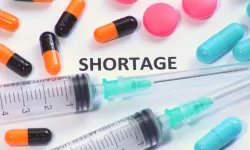In-Depth Content

Long Grove Pharmaceuticals, an experienced and innovative pharmaceutical company specializing in complex generics and proprietary 505(b)(2)s, leverages its heritage of success through in-house research and development from parent company Capstone Development Services. Long Grove distinguishes itself in the generic pharmaceutical market with innovative approaches encompassing People, Products, and Processes. This includes in-house R&D for differentiated generics supported by Capstone, dedicated supply chains to introduce new supply to the U.S. market, and a seasoned leadership team fostering collaborative partnerships with customers and suppliers. Differentiated generics are delivered through proprietary products developed via the 505(b)(2) pathway, aided by rapid approvals and process efficiencies. Supply chain continuity and reliable partnerships further reinforce Long Grove's commitment to providing novel solutions to the healthcare sector.

The issue of drug shortages is an enduring problem, dating back to the early 1920s with the first traceable shortage being insulin. National tracking of drug shortages began in 2001, highlighting the persistent nature of this challenge. Despite over a century worth of awareness and opportunity, patients and healthcare providers continue to grapple with drug shortages. Although the idea of “drug shortages” is not exclusive to certain regions or facility type, each healthcare entity navigates these overlapping challenges in its own unique way, reflecting the widespread but varied impact of this ongoing issue.
We started the first quarter of 2024 by breaking historical records, reaching an all-time high of 323 active drug shortages, with nearly half being generic sterile injectable (GSI) medications. The challenges in patient care due to interruptions in GSI availability, coupled with financial implications, are significant. It's estimated that hospitals collectively spend upwards of $600 million per year managing drug shortages. This includes direct costs associated with more expensive, non-preferred products, increased labor costs due to alternative preparation requirements, higher operational carrying costs from increased standard stock amounts, and perhaps most frustratingly, waste once the shortage is resolved.
While no product interruption is ideal, some are more understandable than others. These include manufacturing delays due to equipment maintenance or repair, precautionary batch failures due to suspected quality control issues, or natural disasters. On the flip side, shortages caused by single-source producers dominating the market, significant violations leading to an FDA Form 483, or a diluted product margin resulting in negative value-added situations across multiple manufacturers are less palatable within a fragile system responsible for the health of a nation.
More recently, in response to these concerns, the U.S. Department of Health and Human Services (HHS) released a jointly sponsored white paper titled "Policy Considerations to Prevent Drug Shortages and Mitigate Supply Chain Vulnerabilities in the United States." In this white paper, HHS emphasized the importance of developing and implementing a collaborative, shared accountability model for drug shortage prevention. This model consists of two key components: the Manufacturer Resiliency Assessment Program (MRAP) and the Hospital Resilient Supply Program (HRSP).
The combined program aims to enhance market transparency for GSIs, promote volume-based purchase decisions with a sustainability focus rather than a "race-to-the-bottom" approach, and improve reliability by incentivizing investments in supply chain resilience and diversification. This includes initiatives such as expanding domestic manufacturing and production of key ingredients. However, there's also the potential for hospitals to face penalties under this framework.
Although an official statute has not yet been enacted into law, this is a critical issue. Institutions should take this opportunity to thoughtfully develop and refine clear processes and policies for managing drug shortages at the local level. The following factors should be considered when constructing your inventory management plans during a shortage and preparing to understand your financial position throughout.
Important discussion points to consider when developing your drug shortage management process:
- Work closely with your external pharmacy procurement stakeholders. Vendors such as drug manufacturers, wholesalers, and Group Purchasing Organizations (GPOs) can be invaluable partners. Each partner has the potential to add significant value to your organization.
- Internally, build relationships with key stakeholders across all care areas that may be impacted by a drug shortage. This ensures you understand who can be involved in developing a detailed mitigation plan.
- Determine the appropriate level of inventory for your facility and establish protocols for adjusting standard stock amounts during a shortage. This is a crucial component of financial stewardship during a shortage. Avoid panic-buying all available products in every dose and size to prevent product wastage and tighter constraints caused by a bullwhip effect.
- Conduct frequent huddles with purchasing team members to maintain a consistent understanding of product availability in the market. Daily structured huddles, even if brief, are ideal. Provide broader communication on a weekly basis to all pharmacy leadership for situational awareness, with meaningful escalation as needed. For larger Integrated Delivery Networks (IDNs), establish a system-level committee to review new, active, and pending mitigation plans.
- Organize a response process for activating a drug shortage plan and proactively plan mitigation strategies when monitoring indicates a potential shortage. Start discussions early with key pharmacy staff and select providers to determine preferred treatment alternatives. Do not assume that a pending shortage will be automatically communicated to the relevant stakeholders.
- Leverage your informatics and automation technologies to alert and guide providers to the shortage mitigation strategy, ensuring that any available product is reserved for patients who need it most.
- Identify ways to stretch your current supply to benefit as many patients as possible. Strategies include reducing automated dispensing cabinet PARs, strategically planning compounding for products that contain more than one dose, and shifting inventory from low-use to high-use areas. Work with key internal stakeholders to ensure changes are made with full awareness, for instance in the previous examples, ensure billing units do not result in overcharging during batch preparation of doses or that a PAR reduction does not interfere with urgent response protocols.
- Finally, revisit partnerships and how they can support you during drug shortages. Partners such as wholesalers, GPOs, and manufacturers can collaborate on plans to purchase short-dated products that would otherwise be wasted or enroll in commitment programs that ensure sustainable product availability through predictable and consistent volume needs. Both approaches can reduce your financial burden during shortages, with commitment programs offering proactive shortage prevention; understanding that these programs are most impactful prior to a shortage occurring.

What is psychological safety? Psychological safety is a shared belief that one will not be punished or humiliated for speaking up with ideas, questions, concerns, or mistakes. In a psychologically safe environment, people feel comfortable in asking a question, raising a concern, providing feedback, and contributing to a discussion without fear of negative consequences.
Why have a psychologically safe environment? There are many benefits to creating a psychologically safe environment in a pharmacy including increased workforce engagement and motivation, increased safety culture, and decreased patient harm. Interestingly enough, psychological safety is embraced by other industries such as the technology industry for its ability to drive innovation.
How can I create a psychologically safe environment in my pharmacy?
- Share errors. Start daily huddles and team meetings with a safety story. Keep things simple, short, and sweet. Rotate who shares each day. Recognize and reward people for speaking up and sharing errors and close calls. This is also great opportunity to share what has been done to address past errors. As a leader, practice active listening as things shared could be future process improvement projects!
- Thank people for sharing their opinions – even when you may disagree! In a psychological safety training exercise I attended, we were asked to discuss as a group what it would "feel" like in a psychologically safe environment of which we thought everything would be rosy with hearts and rainbows. Our instructor shared that psychological safety can feel uncomfortable. We were all dumbfounded. The instructor went on to explain that as a leader, you may not be used to someone disagreeing with you which will feel uncomfortable. Fight the urge to defend your position and just remember that everyone brings a unique perspective.
- Model vulnerability. As leaders, we feel like we should have all the answers, fix all the problems, and be absolutely perfect all the time. Leaders are humans too. There is no shame in asking for help which may take the form of delegation, collaboration, or even having motivated team members take on a stretch project. Additionally, admitting to the team your mistakes and shortcomings shows vulnerability, builds trust, and sends a message that everyone makes mistakes but we can all learn from it.

The pharmacy supply chain is extremely complex, and the stakes are high for healthcare organizations. It falls on the shoulders of health system and hospital pharmacy leaders, along with their teams, to not only prepare and dispense drugs accurately and safely, but also manage all the processes and requirements related to drug products from procurement through point of use.
Discover the challenges keeping health system and pharmacy leaders up at night, and how U.S. health systems and hospitals are addressing them through supply chain management optimization.

Soaring drug prices are putting the squeeze on pharmacies, but you have the power to resist the trend. Advanced analytics can help your pharmacy loosen hyperinflation’s grip.
From 2022 to 2023, drug prices surged by 15.2%, on average, on top of an 11.2% increase the previous year, significantly outpacing inflation. This past year’s increase constitutes an average difference of $590 per drug, putting big pressure on providers nationwide.
The increases are especially bad news for rural hospitals, where over 600 facilities, or 3 in 10, were at risk of closure in 2023 due to financial instability.
Mitigating the impact of rising costs is an industry priority: 71% of hospital pharmacy participants recently stated that streamlining pharmacy purchasing and procurement was an essential priority for them this year.
The good news is they can do just that.
Where’s the opportunity?
There’s plenty of opportunity among the 40,000 to 60,000 NDC prices hospitals must evaluate daily, given nearly 2,500 preferred NDCs and eight NDC options per therapeutic group.
Most hospitals have been managing this supply chain with low-tech tools like Excel. Many also rely on traditional siloed GPO tools, wholesale portals, and TPA software. Despite pharmacies’ best efforts, this fragmentation hampers data-driven decision-making, creating gaps, deficiencies, and waste.
Traditional procurement approaches also prioritize compliance over financial performance, missing potential improvements in fiscal optimization and sustainability. Even hospitals using newer analytics focus mostly on inventory tracking and supplier consolidation.
Cost-reduction reality
Pharmacy supply chain teams need more. In my view, they need integrated analytics created specifically to optimize spending through blended prices, real-time cost pricing data, and clear visibility into potential savings.
Hospital executives generally understand this need and intend to address it. More than half say data-driven improvements in supply chain management can improve margins by at least 1% to 3%, according to a Sage Growth Partners Survey. The challenge, however, has been creating the right solution.
Fortunately, some hospital systems are adopting purpose-built innovations that surface potential cost savings and elevate the highest-potential opportunities to the top of an integrated dashboard.
These solutions provide transparency around all available drug options to ensure a hospital system gets the best prices and is fully stocked with the drugs it needs. From 2023 to 2024, there was a significant increase in the adoption of new software technologies to help combat purchasing problems, with 25% of respondents turning away from their wholesaler tools compared to 8% the previous year.
Millions of dollars recouped
We looked at 140 hospitals using state-of-the-art purchasing-optimization technology and workflows developed by pharmacists. These leaders saved $27 million in 2023 through real-time data-driven recommendations for better purchasing options. The recommendations considered preferred NDCs, GPO compliance, availability, and WAC, GPO, and 340B ratios.
For the pharmacy professional, a useful real-time purchasing-optimization dashboard provides three simple workflows:
- A direct savings workflow that flags overcharges and recommends lower-priced options for identical products and hard-dollar ROI.
- A cost avoidance workflow that flags 340B insights, contract management opportunities, and impending price increases, preventing overcharges before they happen.
- An oversight workflow that monitors spending, shortages, and GPO compliance.
Relief is in reach
Now, any hospital system can have a bird’s-eye perspective of these workflows in their organization, viewing similar sites in “groups” and facilitating standardized buying practices where applicable. Buyers can dive deeper into any recommended change with a simple click.
Developing such a system doesn’t have to be a major IT undertaking. It’s more about gathering primary data: a wholesaler account list, a 12-month inventory history, 340B covered entity status, and GPO’s preferred NDC list. Standard templates help pharmacy departments connect to major wholesalers.
As a hospital pharmacy, there’s not a lot you can do to prevent drug prices from rising. But you can do more to find the best available price for every purchase. Analytics, dashboards, and the data you already have point the way.

Medication Safety is one of those terms that can be woven into anything related to medications. Adverse event from an anticoagulant? Medication safety. Sterile compounding? Medication safety. Regulatory compliance? Medication safety. Medication administration? Medication safety. REMS? Medication Safety. Electronic order sets? Medication safety. The list can go on and on and on and rightfully so since safety plays a role throughout the entire medication use process. While many medication safety officers do juggle one or several of these responsibilities, at the heart of any medication safety program is reducing the risk of medication errors and patient harm. Here are 5 things you need to know NOW about medication safety.
Safety culture makes ALL the difference. Safety culture is one of those weird intangible concepts that is difficult to explain or put your finger on but has such a profound effect on how situations can unfold. I’ve given many lectures on safety culture, and I always like to start by painting a picture of a busy pharmacy and looking at how a scenario could unfold in different safety cultures. In a strong safety culture, an error is caught before leaving the pharmacy and a system fix is later put in place to prevent that error from happening again. In a lower safety culture, an error reaches the patient who subsequently goes into cardiac arrest resulting in an overhead call for a code blue. Again, hard to put your finger on exactly what it is, but has a profound effect. I can go into many technical aspects of safety culture, but I’ll spare you the details. The key takeaway is that it all starts with psychological safety or how comfortable everyone is with speaking up, disagreeing openly, or asking questions without fear of negative repercussions. In a later article, I’ll provide more specific tips on how to build psychological safety at your pharmacy.
Saying (and repeating) “BE MORE CAREFUL!” does NOT make a safer system. Instead, higher leverage strategies are needed to prevent errors. The Institute for Safe Medication Practices has an infographic entitled the ‘hierarchy of effectiveness of risk-reduction strategies’ that displays low, medium, and high-leverage strategies. Low-leverage strategies, such as educational programs and telling someone to “Be more careful!”, focus on human reliability. As humans are fallible and to err is human, we simply cannot educate ourselves to safety. Medium-leverage strategies are a step above and include redundancies and alerts but may need reinforcement and periodic updating. High-leverage strategies, such as forcing functions, computerization, and automation, may take longer to implement, but is most effective because it can eliminate the risk of errors altogether. So, if you find yourself saying “BE MORE CAREFUL!” over and over again, pause, check yourself, and ask ‘What higher leverage strategies can we put in place to prevent this error from happening again?’
Learn from events that happen outside your organization. There is something called normalcy bias when errors occur at outside organizations where people think ‘That won’t happen here.’ But guess what? It can and it will. Don’t rely on solely on reported medication errors at your organization! Look proactively at events that happened at other organizations and learn from them. Identify gaps internally based on the shared event and work to close those gaps before the same error occurs at your organization.
Every healthcare institution needs a dedicated medication safety leader. The American Society for Health-System Pharmacy (ASHP) has a white paper on the need for a dedicated medication safety leader that I highly encourage all pharmacy directors to read. Medication safety simply cannot be another hat one wears as a pharmacy manager or director who is also managing budgets, monitoring financial performance, implementing cost-saving measures, addressing regulatory concerns, maintaining a competent and engaged staff, and more! A medication safety leader sets the medication safety vision, identifies opportunities to improve the medication-use process, and leads efforts and initiatives to prevent medication errors. Advocate for a dedicated medication safety leader at your institution and use patient safety stories to drive home the need.
- You are not alone! I meet a variety of people in medication safety. Those who juggle multiple responsibilities where medications safety is just one of the many balls they need to keep up in the air. Those who have a dedicated role in medication safety but feel like they are carrying the weight of the world on their shoulders. Those who are new to medication safety and don’t know where to start. One thing that I say to everyone in medication safety is ‘You are not alone!’ There are a ton of resources out there (e.g. ASHP Medication Safety Resource Center and the Institute for Safety Medication Practices newsletters and self-assessment tools) that you can and should leverage. You can also connect with others in medication safety via forums such as the Medication Safety Officers Society (MSOS) or ASHP Connect for Medication Safety. I also highly encourage joining state or national professional organizations that have a medication safety group to have a network of other medication safety professionals you can lean on and learn from!

Long Grove Pharmaceuticals, an experienced and innovative pharmaceutical company specializing in complex generics and proprietary 505(b)(2)s, leverages its heritage of success through in-house research and development from parent company Capstone Development Services. Long Grove distinguishes itself in the generic pharmaceutical market with innovative approaches encompassing People, Products, and Processes. This includes in-house R&D for differentiated generics supported by Capstone, dedicated supply chains to introduce new supply to the U.S. market, and a seasoned leadership team fostering collaborative partnerships with customers and suppliers. Differentiated generics are delivered through proprietary products developed via the 505(b)(2) pathway, aided by rapid approvals and process efficiencies. Supply chain continuity and reliable partnerships further reinforce Long Grove's commitment to providing novel solutions to the healthcare sector.

In an evolving time for Pharmacies across the nation, picture a blank canvas. You may ask why? What does this have to do with pharmacy and healthcare? I want you to take a journey with me to the small beginnings I did not despise when it came to our Pharmacy department.
Insight Hospital Chicago is the oldest hospital in Chicago. Its located on the south side of Chicago in a community where the age expectancies vary between 10 minutes of each other. The hospital is a safety net and prizes on the 340B drug program. The spring of 2022 presented the real test. Insight was 100% independent from the previous company. The pharmacy department was a blank canvas with great potential for success.
One of the first discussions was to become dually accredited as a specialty pharmacy. My physical perception of that goal was questionable. We were only an outpatient retail pharmacy servicing a lower number of the hospital and community every week. My inward perception was based on faith that all things are possible. This was the passion that drove us to achieve this vision. When it came to specialty accreditation, we decided to pursue Utilization Review Accreditation Commission (URAC) first. The blank canvas was beginning to have color now. URAC accreditation was very extensive and intense. We rebuilt and reshaped the outpatient pharmacy in many ways. The policies, procedures and workflow were targets that help to provide infrastructure to the department. Within less than one year the outpatient received approval for full accreditation with no findings. This was a mark in history for the pharmacy department and for the hospital. Who would have thought the pharmacy would be able to achieve this in such a quick time. The doors were opening now in many ways. We were now able to get access to limited distributions drugs (LDD), had the payors open more to the pharmacy which helped to support the business. The hospital also gained more awareness in the community. The canvas was becoming fuller and more colorful.
The next accreditation we received for 9 months was Accreditation Commission for Health Care (ACHC). After this second accreditation, the outpatient pharmacy was put on the map. To become dual accredited within one year served as a success and legacy. Our Insight Chicago Pharmacy has gained more traction and notoriety. The canvas went from being blank and empty to full, vibrant and history in the making. Our pharmacy department considered the small beginnings and used that as a guide for the legacy we have now.
Telehealth is a program that has taking off with the Pharmacy at Insight. Through the Collaborative Drug Therapy Management (CDTM) program, the team is able to partner with providers and give the best patient experience. With this program in place, our prescription volume has exponentially increased from where we started. We can now firmly say the pharmacy department at Insight Chicago is flourishing. This also provides great support for the hospital, which is a big pillar in the community. The canvas is now filled and beautiful. It is diverse and versatile. It wouldn’t have gotten this way without a team. Everyone in the pharmacy department worked as a team. From the pharmacy technician to the Chief Pharmacy Officer (COP), there was communication and teamwork. This is what made the vision manifest and come to life!
To conclude, all things are possible when it comes to new beginnings. Health systems across the nation have pharmacy departments that have been long standing and already build our full workflow and operations. The question becomes, what happens when you meet a pharmacy department that is not? Where do you start on making it fully functional, unique and with purpose? Consider the blank canvas journey that I went through and know there are open skies of opportunities. One can start with an vision and believing from within.

One of the greatest and ongoing conveniences that offers constant progress certainly lies in technological advances. We see this in every aspect of our daily lives. For evidence of the massive societal shift that technology offers look no further than your cell phone, tablet, or computer. It’s a safe bet that once you think you have it down, the next shiny toy hits the market.
Healthcare, particularly Pharmacy, is not immune to these phenomena. The rapid advancement in all areas of Pharmacy practice aided with well positioned technology has presented an array of opportunities to assist a well-oiled Pharmacy program to elevate to the next level. With that comes the responsibility to utilize the appropriate technology based on the individual needs of the practice environment and to go all in. Think of that treadmill you had to have on January 2nd, to embark on your New Year’s resolution. You either have your ticket to your beach body or a $2000 hanger. It’s all up to you how you employ your shiny new toy.
Let’s look at a few topline thoughts on technology and the how/why you would want it, how you would use it and what may be worth it or not based on your strategic focus.
The first thing to evaluate is your clinical programming and the human involvement you want to incorporate. For this you must evaluate several key points, such as how you want your technicians and pharmacists to matriculate outside the pharmacy. For example, if you want pharmacists rounding more, perhaps have them decentralized permanently, or have technicians circulating on the floors and in the ED say for medication reconciliation, then you need to have the technology to perform automated duties in the pharmacy.
Next you need to look at the cost element. Just because it looks great and has a significant price tag doesn’t mean you need it. Look at the contracts you have to see where you can make deals or lean into a barter type relationship. Maybe if you offer to be a Beta site for new technology, you can get a much better deal if you are willing to share outcomes. Maybe you haven’t made the most of economies of scale and you have some opportunities there.
The next big question is your regulatory readiness and how well you have performed in recent surveys. If you find you are running a fire drill every time you have to produce data on survey, then the technology you need is more along the lines of automated reporting and/or catching issues in real time. For example, if you have automated medication dispensing cabinetry and need to produce diversion information, the reports that are baked into this technology are invaluable.
In terms of technology groupings, let’s break them down into bite size pieces.
Automated Dispensing Machines. Most likely you already have this or want it. The question is do you use all or most of what this system has to offer? Do you have overlapping technology that you don’t need because you have not tapped into the full cadre of offerings your chosen system is capable of? The companies that sell this technology also offer support that is baked into the contract. Talk to them about what they suggest and schedule training and overviews a couple times a year to assure you are up to date on the software, are using the administrative options to their fullest capacity and evaluating anything new that may have been rolled out on their platform. This may seem like a no-brainer although you may be surprised at what you have been missing out on. Maximize everything in your chosen system to create diversion protocols, reduce possible adverse events and to stay ahead of the last outdated pill lurking around just begging to be found on your next survey.
Remote Verification. Let’s say you want to, need to or have no choice but to keep the FTE component down. Depending on your state laws, you likely have the ability to incorporate your ADM’s with remote verification for overnight coverage for example, thus not relegating this to the emergency cabinet that has to be reconciled the next day as well as offering real-time verification of the order to satisfy regulatory oversight. Pharmacy should not be practiced only during daylight hours.
RFID. There are so many options here and the technology is great, but not widespread and/or financially attainable which means grouping RFID into buckets. It can be used for specialty medications using technology that is like a hotel mini fridge essentially making these consignment medications. You only pay when you use them and get reminders when these wildly expensive therapies are about to go out of date. Another great grouping is code cart replenishment and documentation, two big issues for every hospital since the beginning of time. RFID technology can make refilling and checking the trays much more streamlined, allowing for the redirection of pharmacists’ time incorporating the reporting from the RFID and tech on tech checking depending on state laws.
Computerized Physicians Order Entry. Everybody must have it. Many are annoyed by it. Here’s the thing, gradually increasing the use allows for order sets to be used more effectively as well as testing the limits of policy acceptance. Let’s say that your hospital has approved TPN to be written by Clinical Nutrition, and the orders are based on pre-mixed PPN and TPN. In this scenario, physicians’ time is eased up, treatment is expedited, the expertise of Clinical Nutrition is appropriately employed, and the relevance of the program can be evaluated by the reporting that can be obtained. This is an excellent story to tell when the JC shows up in your lobby.
We have mentioned just a scant few of the possibilities available to create an optimized technology infused clinical environment. The choices available and reasoning for use could go on for many articles with one overarching theme which is when thinking about what you have, what you want and what makes sense take the whole picture into account as well as your ability to make the most of your options. To achieve this, ask yourself a few key questions. Am I using what I have to full capacity? What gaps do I need to fill in? Where are our vulnerabilities and what do we struggle with? If you work backwards from there you can engage in a more mindful fashion all around turning your attention to the technology that works for your patients and your practice.

Hospitals and healthcare providers continue to face challenges due to drug shortages. As we know, shortages affect both patient care and treatment protocols. Many life-saving medications have been identified in short supply, posing potential risks to patient outcomes and requiring strategic management and alternatives by healthcare professionals. Hospitals must stay ahead by ensuring the availability of robust strategies to manage these shortages, ensuring that patient care remains uninterrupted and safe.
Here are some actionable strategies and reminders to consider for managing drug shortages effectively.
Strategies for Managing Drug Shortages
Alternative therapies: Identify and validate alternative drugs or therapeutic modalities that can effectively replace the shorted medication without compromising patient care.
Supplier diversification: Work toward diversifying suppliers and manufacturers for critical drugs to reduce the impact of a shortage from a single supplier.
Usage guidelines: Implement guidelines for the use of drugs in short supply, prioritizing patients for whom the medication is most critical.
Stock management: Optimize stock levels by monitoring consumption patterns and adjusting stock levels accordingly to prevent overstocking and understocking.
Collaboration: Engage in collaborative efforts (if possible) with other hospitals and health systems for sharing resources during acute shortages.
Patient communication: Ensure transparent communication with patients regarding drug shortages, potential impact on treatment, and available alternatives.
Long-term Solutions
Advocacy: Participate in advocacy efforts aimed at addressing the root causes of drug shortages through regulatory reforms and industry engagement.
Technology adoption: Utilize technology for better forecasting and managing of drug inventories, including the use of artificial intelligence (AI) and machine learning algorithms.
Education: Keep the healthcare team informed and educated about managing drug shortages, including training on the use of alternative therapies and adjusting dosages.
Some Key Drug Shortages
These are a few of the current drug shortages, focusing on medications that may be critical for patients in the hospital setting. These medications are often used in acute settings, emergency care, or the treatment of serious conditions, making their availability crucial.
Amiodarone injection
Significance: Critical for use in the treatment for serious arrhythmias, such as ventricular tachycardia. Its importance lies in its ability to stabilize heart rhythms.
Ciprofloxacin injection
Significance: As a broad-spectrum antibiotic, ciprofloxacin injection plays a critical role in treating bacterial infections. It is especially valuable in treating infections in patients who cannot tolerate or absorb oral antibiotics.
Methotrexate injection
Significance: An essential chemotherapeutic agent and immunosuppressant used to treat various cancers. Its injectable form is crucial for cases requiring high bioavailability and rapid onset of action.
Midazolam injection
Significance: A benzodiazepine used for sedation, anxiolysis, and amnesia before medical procedures and in the ICU for sedating patients.
Nitroglycerin injection
Significance: Nitroglycerin is a critical medication used primarily in the management of acute episodes of angina pectoris and the treatment of heart failure associated with acute myocardial infarction. Its rapid vasodilatory effects can relieve chest pain by increasing blood flow to the myocardium and decreasing the heart’s oxygen demand.
Somatropin injection
Significance: A synthetic growth hormone, somatropin is used to treat growth hormone deficiency in children and adults. Its role is crucial in promoting normal growth and development in children.
For a detailed and up-to-date list of all current drug shortages, healthcare professionals should consult ASHP and FDA drug shortage lists directly. These resources offer comprehensive information on each shortage, including reasons for the shortage, available products, and estimated resupply dates, all of which are crucial for effective shortage management and patient care planning.
Drug shortages pose significant challenges to healthcare teams, requiring a proactive and strategic approach to ensure uninterrupted patient care. By staying informed about the current shortages and utilizing a combination of short-term management strategies and long-term solutions, hospital pharmacies can navigate these challenges more effectively.